Mausoleum of Al-Hakim Termeziy
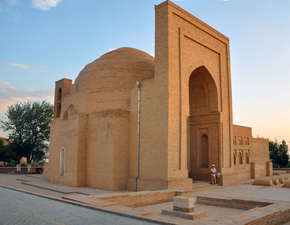 The architectural complex of mausoleum of Hakim al-Termezi formed near the northwest corner of the citadel of Termez for centuries. In this sparsely western part of Old Termez is the tomb of the IX century scholar, founder of the dervish order "Hakimia" Abu Abdullah Muhammad Bini Ali Hakim at-Termizi, revered as the spiritual patron of the ancient city.
The architectural complex of mausoleum of Hakim al-Termezi formed near the northwest corner of the citadel of Termez for centuries. In this sparsely western part of Old Termez is the tomb of the IX century scholar, founder of the dervish order "Hakimia" Abu Abdullah Muhammad Bini Ali Hakim at-Termizi, revered as the spiritual patron of the ancient city.
Al-Hakim at-Termezi was born in 810 in Termez. From childhood Termezi sought knowledge. Up to 25 years, he studied at various schools of Maverannahr (Central Asia). Along with the natural sciences, he eagerly studied the religious sciences. After studying all that was available in their native land, he went to Baghdad to expand their knowledge. Baghdad was then a center of science and education, there lived and worked in many prominent scholars of the time. Later Termezi moved to Basra. He stayed there for several years and then made a pilgrimage to Mecca. After the pilgrimage, he returned to his native Termez, where he worked as a teacher and scholar.
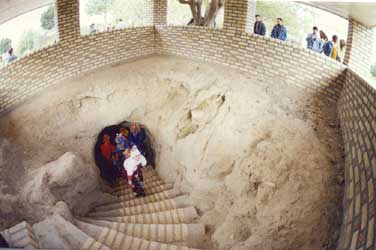 At the age of 27-30 years, At-Termezi turned his attention to Sufism, after he read a book by the famous Sufi al-Intikomiya. The book, calling on the path to understanding the essence of faith to reject the desire for material things, deeply impressed by At-Termezi, prompting him to begin life of a hermit, and retire from worldly affairs. Since then he has only met with his students and scholars colleagues, spent a lot of time reading. At-Termezi established a relationship with Sufis of Baghdad and Egypt. He made an outstanding contribution in promoting Sufism in Central Asia.
At the age of 27-30 years, At-Termezi turned his attention to Sufism, after he read a book by the famous Sufi al-Intikomiya. The book, calling on the path to understanding the essence of faith to reject the desire for material things, deeply impressed by At-Termezi, prompting him to begin life of a hermit, and retire from worldly affairs. Since then he has only met with his students and scholars colleagues, spent a lot of time reading. At-Termezi established a relationship with Sufis of Baghdad and Egypt. He made an outstanding contribution in promoting Sufism in Central Asia.
At-Termezi is author of over 400 valuable scientific and religious works, of which have reached us only 57. The content of these unique works shows that the At-Termezi was a prominent expert in Islamic law, philosophy, history, astrology, mathematics and linguistics of his time. He was very erudite, and science has been his main interest. His contemporaries called him "the wisest of the wise." Throughout his life he worked only for the benefit of people, so people respectfully called him "Termez-ota" (Termez-father).
According to the book of Egyptian sheik Abdulfattoh Baraka, At-Termezi lived a long life and died at the age of 115 years in Termez in 932 and was buried in the medieval citadel of Termez. Over time, over the grave was erected a mausoleum became a popular place of pilgrimage. Here to worship at the sacred tomb come not only locals but also pilgrims from other countries in the Muslim world.
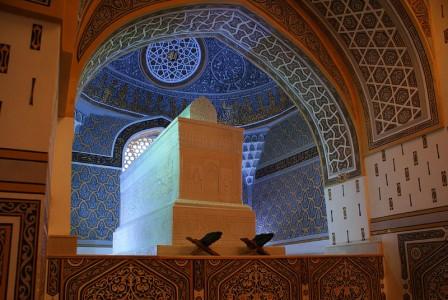 In the XIX century on the site of the temple was built four-domed building of mud brick. In the mausoleum burial was found on three-tier white carved marble tombstone "Sagana", covered with beautiful carvings. At the end of the tombstone epitaph inscribed: "In the name of the person to whom praise. This markad Shaykh, Imam, scholar, saint Abu Abdullah Muhammad Bini Ali Hakim Termizi, may God have mercy on him. He was the greatest of the great Sayyid, possessed a high eloquence, wrote famous works and has made remarkable sayings. He was a friend of Abu Abdullah Bukhari, the author's book "Sahih". Yes, have mercy on him. Among the shaykhs, he studied law better than lawyers hanafian, may God have mercy on him. Died, let God save him, in the year 255 / 869 ".
In the XIX century on the site of the temple was built four-domed building of mud brick. In the mausoleum burial was found on three-tier white carved marble tombstone "Sagana", covered with beautiful carvings. At the end of the tombstone epitaph inscribed: "In the name of the person to whom praise. This markad Shaykh, Imam, scholar, saint Abu Abdullah Muhammad Bini Ali Hakim Termizi, may God have mercy on him. He was the greatest of the great Sayyid, possessed a high eloquence, wrote famous works and has made remarkable sayings. He was a friend of Abu Abdullah Bukhari, the author's book "Sahih". Yes, have mercy on him. Among the shaykhs, he studied law better than lawyers hanafian, may God have mercy on him. Died, let God save him, in the year 255 / 869 ".
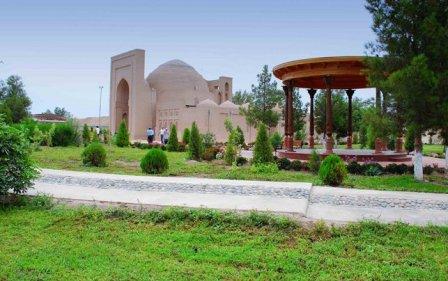 Later in the shape of the ensemble has changed. The main building of the mausoleum was torn down, on the remains of its walls built new from the brick. Rebuilt also the building adjacent to the east. They were all raised on a platform. Within the walls of "kari khana" arranged narrow vertical through-slot that went round the mausoleum, so they could hear the voice of "kari", reading the funeral prayer. The tombs were joined a broad arched opening. Fencing of the yard and brick, they are also faced with the wall of old Sufi cell. To the south of the farm buildings are located “khanaka”. These on ceramic "kuburs" (piped) water came. It prepared the food for its inhabitants and pilgrims.
Later in the shape of the ensemble has changed. The main building of the mausoleum was torn down, on the remains of its walls built new from the brick. Rebuilt also the building adjacent to the east. They were all raised on a platform. Within the walls of "kari khana" arranged narrow vertical through-slot that went round the mausoleum, so they could hear the voice of "kari", reading the funeral prayer. The tombs were joined a broad arched opening. Fencing of the yard and brick, they are also faced with the wall of old Sufi cell. To the south of the farm buildings are located “khanaka”. These on ceramic "kuburs" (piped) water came. It prepared the food for its inhabitants and pilgrims.
In the late 50s XX century were carried out restoration work and detailed research, and in the 80s was restored decor of the main mausoleum. In 1990, UNESCO celebrated the 1000th anniversary of this esteemed Sheikh and were confined to this reconstruction of the object.
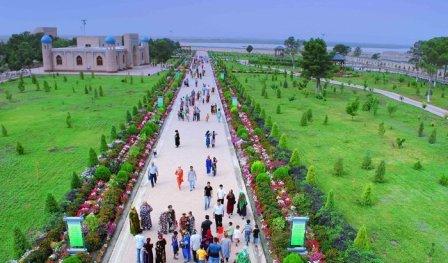 The studies revealed that the mausoleum, occupying a relatively small area (about 590 sq. m.), was one of the most complex of the medieval monuments of the number of buildings erected over the centuries, one above the other. Layers are composed of masonry and adobe brick, interspersed with numerous graves, decorative items and household ceramics. Irregularities of the relief, reconstruction and repairs, burial chambers talk about the history of the ensemble. Prior to the first buildings are located a Buddhist temple. From a preserved base of columns, fragments of parts, burnt bricks, the remains of aqueducts and household ceramics Kushan period.
The studies revealed that the mausoleum, occupying a relatively small area (about 590 sq. m.), was one of the most complex of the medieval monuments of the number of buildings erected over the centuries, one above the other. Layers are composed of masonry and adobe brick, interspersed with numerous graves, decorative items and household ceramics. Irregularities of the relief, reconstruction and repairs, burial chambers talk about the history of the ensemble. Prior to the first buildings are located a Buddhist temple. From a preserved base of columns, fragments of parts, burnt bricks, the remains of aqueducts and household ceramics Kushan period.
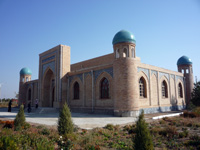 Since gaining independence, the works on restoration and imp rovement of this unique monument of culture. Craftsmen from all over the country have contributed to the restoration of the architectural complex. Work time-consuming, because it was necessary to preserve the original appearance. And judging by the results, it is succeeded. Significantly expanded the surrounding area of the complex, it is now landscaped, planted trees and flowers. Installed special lighting. Thus, the original features of the ancient monuments of architecture complemented with new bright colors today. Undoubtedly, this will allow a better study and understand the history of the region, which has always aroused great interest worldwide.
Since gaining independence, the works on restoration and imp rovement of this unique monument of culture. Craftsmen from all over the country have contributed to the restoration of the architectural complex. Work time-consuming, because it was necessary to preserve the original appearance. And judging by the results, it is succeeded. Significantly expanded the surrounding area of the complex, it is now landscaped, planted trees and flowers. Installed special lighting. Thus, the original features of the ancient monuments of architecture complemented with new bright colors today. Undoubtedly, this will allow a better study and understand the history of the region, which has always aroused great interest worldwide.
The complex was built in the museum which exhibits rare artifacts found during archaeological excavations carried out simultaneously with the restoration.
In preparing the articles used material site http://mcs.uz
 The architectural complex of mausoleum of Hakim al-Termezi formed near the northwest corner of the citadel of Termez for centuries. In this sparsely western part of Old Termez is the tomb of the IX century scholar, founder of the dervish order "Hakimia" Abu Abdullah Muhammad Bini Ali Hakim at-Termizi, revered as the spiritual patron of the ancient city.
The architectural complex of mausoleum of Hakim al-Termezi formed near the northwest corner of the citadel of Termez for centuries. In this sparsely western part of Old Termez is the tomb of the IX century scholar, founder of the dervish order "Hakimia" Abu Abdullah Muhammad Bini Ali Hakim at-Termizi, revered as the spiritual patron of the ancient city. At the age of 27-30 years, At-Termezi turned his attention to Sufism, after he read a book by the famous Sufi al-Intikomiya. The book, calling on the path to understanding the essence of faith to reject the desire for material things, deeply impressed by At-Termezi, prompting him to begin life of a hermit, and retire from worldly affairs. Since then he has only met with his students and scholars colleagues, spent a lot of time reading. At-Termezi established a relationship with Sufis of Baghdad and Egypt. He made an outstanding contribution in promoting Sufism in Central Asia.
At the age of 27-30 years, At-Termezi turned his attention to Sufism, after he read a book by the famous Sufi al-Intikomiya. The book, calling on the path to understanding the essence of faith to reject the desire for material things, deeply impressed by At-Termezi, prompting him to begin life of a hermit, and retire from worldly affairs. Since then he has only met with his students and scholars colleagues, spent a lot of time reading. At-Termezi established a relationship with Sufis of Baghdad and Egypt. He made an outstanding contribution in promoting Sufism in Central Asia. In the XIX century on the site of the temple was built four-domed building of mud brick. In the mausoleum burial was found on three-tier white carved marble tombstone "Sagana", covered with beautiful carvings. At the end of the tombstone epitaph inscribed: "In the name of the person to whom praise. This markad Shaykh, Imam, scholar, saint Abu Abdullah Muhammad Bini Ali Hakim Termizi, may God have mercy on him. He was the greatest of the great Sayyid, possessed a high eloquence, wrote famous works and has made remarkable sayings. He was a friend of Abu Abdullah Bukhari, the author's book "Sahih". Yes, have mercy on him. Among the shaykhs, he studied law better than lawyers hanafian, may God have mercy on him. Died, let God save him, in the year 255 / 869 ".
In the XIX century on the site of the temple was built four-domed building of mud brick. In the mausoleum burial was found on three-tier white carved marble tombstone "Sagana", covered with beautiful carvings. At the end of the tombstone epitaph inscribed: "In the name of the person to whom praise. This markad Shaykh, Imam, scholar, saint Abu Abdullah Muhammad Bini Ali Hakim Termizi, may God have mercy on him. He was the greatest of the great Sayyid, possessed a high eloquence, wrote famous works and has made remarkable sayings. He was a friend of Abu Abdullah Bukhari, the author's book "Sahih". Yes, have mercy on him. Among the shaykhs, he studied law better than lawyers hanafian, may God have mercy on him. Died, let God save him, in the year 255 / 869 ". Later in the shape of the ensemble has changed. The main building of the mausoleum was torn down, on the remains of its walls built new from the brick. Rebuilt also the building adjacent to the east. They were all raised on a platform. Within the walls of "kari khana" arranged narrow vertical through-slot that went round the mausoleum, so they could hear the voice of "kari", reading the funeral prayer. The tombs were joined a broad arched opening. Fencing of the yard and brick, they are also faced with the wall of old Sufi cell. To the south of the farm buildings are located “khanaka”. These on ceramic "kuburs" (piped) water came. It prepared the food for its inhabitants and pilgrims.
Later in the shape of the ensemble has changed. The main building of the mausoleum was torn down, on the remains of its walls built new from the brick. Rebuilt also the building adjacent to the east. They were all raised on a platform. Within the walls of "kari khana" arranged narrow vertical through-slot that went round the mausoleum, so they could hear the voice of "kari", reading the funeral prayer. The tombs were joined a broad arched opening. Fencing of the yard and brick, they are also faced with the wall of old Sufi cell. To the south of the farm buildings are located “khanaka”. These on ceramic "kuburs" (piped) water came. It prepared the food for its inhabitants and pilgrims. The studies revealed that the mausoleum, occupying a relatively small area (about 590 sq. m.), was one of the most complex of the medieval monuments of the number of buildings erected over the centuries, one above the other. Layers are composed of masonry and adobe brick, interspersed with numerous graves, decorative items and household ceramics. Irregularities of the relief, reconstruction and repairs, burial chambers talk about the history of the ensemble. Prior to the first buildings are located a Buddhist temple. From a preserved base of columns, fragments of parts, burnt bricks, the remains of aqueducts and household ceramics Kushan period.
The studies revealed that the mausoleum, occupying a relatively small area (about 590 sq. m.), was one of the most complex of the medieval monuments of the number of buildings erected over the centuries, one above the other. Layers are composed of masonry and adobe brick, interspersed with numerous graves, decorative items and household ceramics. Irregularities of the relief, reconstruction and repairs, burial chambers talk about the history of the ensemble. Prior to the first buildings are located a Buddhist temple. From a preserved base of columns, fragments of parts, burnt bricks, the remains of aqueducts and household ceramics Kushan period. Since gaining independence, the works on restoration and imp rovement of this unique monument of culture. Craftsmen from all over the country have contributed to the restoration of the architectural complex. Work time-consuming, because it was necessary to preserve the original appearance. And judging by the results, it is succeeded. Significantly expanded the surrounding area of the complex, it is now landscaped, planted trees and flowers. Installed special lighting. Thus, the original features of the ancient monuments of architecture complemented with new bright colors today. Undoubtedly, this will allow a better study and understand the history of the region, which has always aroused great interest worldwide.
Since gaining independence, the works on restoration and imp rovement of this unique monument of culture. Craftsmen from all over the country have contributed to the restoration of the architectural complex. Work time-consuming, because it was necessary to preserve the original appearance. And judging by the results, it is succeeded. Significantly expanded the surrounding area of the complex, it is now landscaped, planted trees and flowers. Installed special lighting. Thus, the original features of the ancient monuments of architecture complemented with new bright colors today. Undoubtedly, this will allow a better study and understand the history of the region, which has always aroused great interest worldwide.














